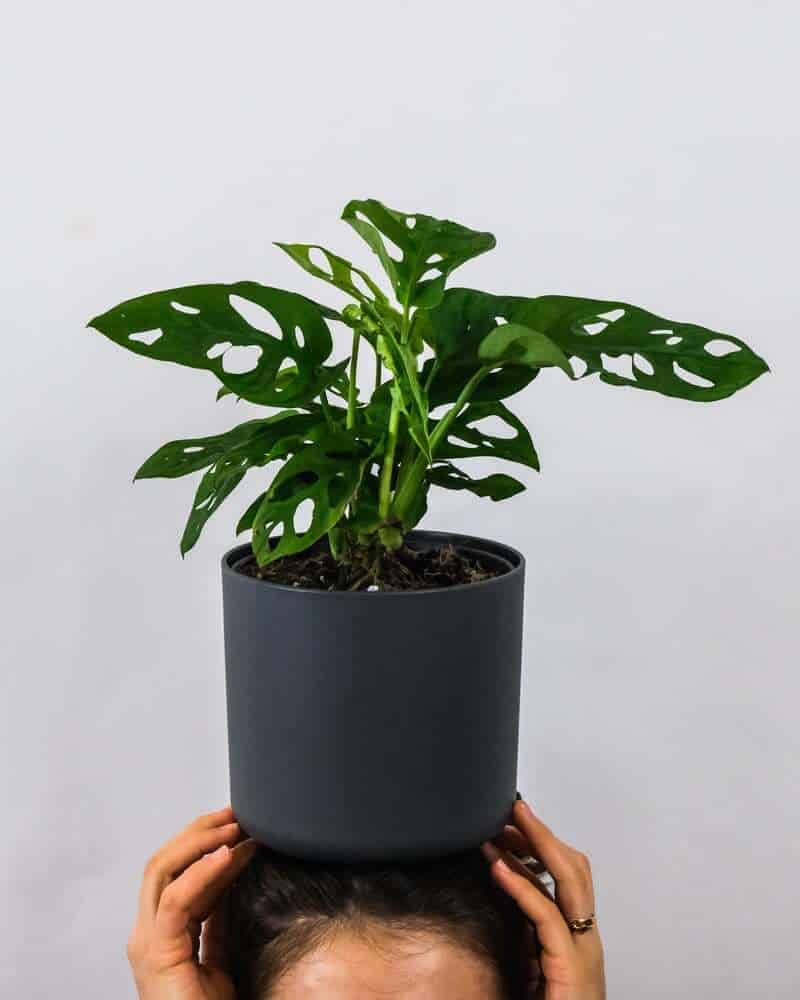Last Updated on January 9, 2023 by a Friendly Gardener
The Monstera adansonii, more commonly known as the Monstera deliciosa is a tropical plant that originates in Central and South America. You may recognize this plant as the “Swiss Cheese Plant”. The M. adansonii has big heart shapes that develop holes known as fenestration as they mature. The holey foliage resembles a slice of Swiss cheese, thus its popular name.
A member of the Aracee family, there are several monstera varieties that are all identified as Swiss Cheese plants. “Monstera” is the plant genus. The most common of these is the Monstera deliciosa, which is more easily recognized by the name“Split-leaf Philodendron”.This variety features lobed leaves with characteristic elongated holes.
The Monstera obliqua is a rare cultivar that has holes so large as to contain more holes than foliage. It resembles a kind of green-hued lace.
The Swiss Cheese Plant is a tropical perennial that is extremely popular as a houseplant. It is impressive with a sculptural quality and easy to care for as an indoor plant. Foliage climbs, so a trellis, moss pole, or stake should be provided. The Monstera is a rapid grower and will arrive at imposing heights quickly.
An indoor Swiss Cheese can be planted any time of year. Seedlings are easily found at nurseries. Indoors your Monstera plant will grow from six to eight feet in height and one to three feet in width. Outdoors the Monsteracan reaches seventy feet in height and will produce white blooms.
Swiss Cheese Plant Care

This ornamental houseplant version of the plant will develop aerial roots that grow from stems. These roots look for support and attach themselves to whatever they find in their path. The gives the plant the appearance of a vining plant. Outdoors these plants use aerial roots to latch onto trees or other types of vegetation. An easy vertical plant to care for, it has a particular look thanks to its characteristic Swiss cheese holes.
Soil
Peat-based soil is recommended as it will retain moisture, yet will not be as subject to becoming soggy as potting soil. Containers need several good drainage holes. An acidic soil pH is recommended between 5.5 to 7.0.
Light
The Swiss Cheese is a native of the tropics, so it enjoys bright indirect light and some partial shade. In their natural habitat, these plants grow beneath large trees in the jungle, so they do not receive direct sunlight. Replicating this environment will protect your plant from leaf scorching. Direct sun can be tolerated in the early morning for a couple of hours only.
Water

This plant needs consistently moist soil that is not soggy. When the soil becomes dry to about an inch deep, give your plant a drink.
Humidity
As a jungle native, the Swiss cheese loves high humidity. These plants are often raised
in greenhouses. Its indoor environment should replicate its natural habitat as closely as possible. Steamy bathrooms are ideal for humidity levels.
If your indoor spot does not have sufficient humidity, begin by misting the plant often. Alternatives to misting include
- A receptacle filled with water placed near the plant
- A space humidifier
- A pebble and water tray with the plant set above the waterline
- Grouping plants together to create localized natural humidity
Temperature
The temperature should not drop below 60° Fahrenheit. A Swiss Cheese plant can survive brief cold episodes but expect some die-back.
Feeding

After the initial potting of your plant, wait about six months before feeding. At six months feed your plant monthly with a liquid fertilizer diluted to about half strength.
Pruning
A Swiss Cheese plant can benefit from a bit of trimming because it is a climber. When growth overwhelms space or the foliage looks unruly, get out the gardening shears for a trim. Prune in the spring or fall. Cut away top growth and damaged foliage as well as dead foliage. Prune foliage close to the stem to eliminate ugly nubs.
Repotting

Repot younger plants annually. A mature Swiss Cheese plant can be repotted every second year but change or refresh soil annually. Without sufficient soil nutrients, growth suffers. Stiff roots can render repotting challenging.
When repotting, get a pot that measures several inches more than the size of the plant’s root ball. Fill a third with fresh soil mixture and place a climbing pole or similar in the center. Position the plant and fill in with soil mix to the plant’s former soil line. Use plant ties to secure the plant to its support.
Swiss Cheese Plant Propagation

Stem cuttings treated with rooting hormone are the easiest method for propagating this plant. You can also place a cutting in water for a few weeks. Expect to wait several weeks for new root development. Cut a stem piece from the plant below a leaf node. Remove all foliage at the bottom of your cutting. Coat the cut tip in rooting hormone and place it in warm moist soil. If you choose to develop roots in a jar of water, once they appear, transfer the cutting to potting soil.
Swiss Cheese Toxicity
The ASPCA informs that a Swiss Cheese plant is toxic to both canines, felines, and smaller animals. The entire plant contains insoluble calcium oxalate crystals. One bite of the plant will release these oxalate crystals and they will irritate the mouth and cause swelling. This is true for the palate, lips, throat, and tongue. With severe ingestion, the upper airway may close partially from swelling impeding breathing. Prevention is the best solution. Locate your plant in a spot that does not permit access to children or pets. If you suspect ingestion, contact a poison control center, medical personnel, or a veterinarian asap.
Oxalate poisoning symptoms most often include:
- Swelling
- Excessive drooling
- Vomiting
- Appetite loss
- Mouth pawing
- Diarrhea
- Mouth or throat blistering
- Mouth or throat pain
- Swallowing difficulty
Pests, Diseases, and Problems
Swiss Cheese plants can attract spider mites, whitefly, aphids, mealybugs, and scale. If you note pests, treat your plant with organic non-toxic insecticide, organic insecticidal soap, or Neem oil. Scale appears as waxy stem deposits that can be removed manually.
Diseases common to the Swiss cheese plant include
- Root and stem rot
- Powdery mildew
- Rust
- Leaf spot which causes yellow or brown spots on foliage.
For fungi infections on plant foliage, treat with a copper-based fungicide.
Foliage will most often point to the problem.
- Yellow leaves are most often a result of overwatering or a lack of nutrients.
- Brown indicates a need for water and higher humidity
- Leaves without holes or splits need more light.
- Curling leaves also point to thirst.
If underwatering is thought to be the problem source, providing more water may not be sufficient. Low humidity levels, compacted soil, or a root-bound Swiss Cheese plant can impede the plant from achieving adequate water intake. Compacted soil will prevent the plant from absorbing water. Root-bound plants with tightly wrapped roots also experience difficulty with water intake.
A Final Consideration
The Swiss Cheese plant boasts striking over-sized shiny green foliage making it an impressive house plant. Both the Monstera adansonii and the Monstera deliciosa will provide a lovely decorative touch to your home or place of business. Since this plant is also easy to care for and very low maintenance, it’s perfect for beginning gardeners and a lovely plant to give as a gift.

